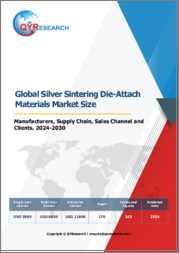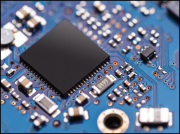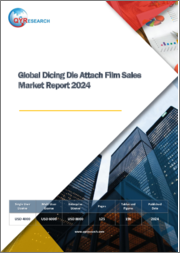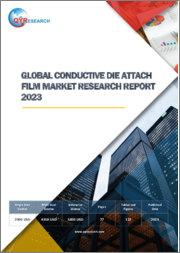
|
시장보고서
상품코드
1589476
세계의 다이 어태치 재료 시장 : 제품 유형, 형상 유형, 재료 유형, 용도별 예측(2025-2030년)Die-Attach Materials Market by Product Type (Adhesive Bonding, Eutectic Bonding, Films), Form Type (Paste, Powder), Material Type, Application - Global Forecast 2025-2030 |
||||||
다이 어태치 재료 시장은 2023년에 7억 6,356만 달러로 평가되고, 2024년에는 8억 934만 달러에 이를 것으로 예측되며, 복합 연간 성장률(CAGR) 6.39%로 성장하여, 2030년에는 11억 7,814만 달러에 이를 것으로 예측됩니다.
다이 어태치 재료는 반도체 산업에서 매우 중요하며 반도체 장치를 기판 및 캐리어에 장착하는 데 사용됩니다. 이러한 재료는 우수한 열 전도성, 전기 전도성 및 기계적 지지를 제공해야 합니다. 다이 어태치 재료의 필요성은 소비자 전자, 자동차, 통신, 산업 분야 등 다양한 용도에서 신뢰성 있고 효율적인 전자 디바이스의 필요성이 증가하고 있기 때문입니다. 주로 이러한 재료는 LED, 전력 반도체, RF 및 MEMS 디바이스의 성능과 수명을 보장하기 위해 매우 중요합니다. 다이 어태치 재료 시장 성장은 소형 전자 가젯 수요 증가, 자동차 및 산업 자동화 동향 증가, 5G와 같은 진화하는 통신 인프라에 의해 뒷받침되고 있습니다. 기술 혁신과 무연, 환경 친화적인 대안으로의 전환은 잠재적인 비즈니스 기회이며 제조업체는 우수한 열 관리 및 연결 특성을 제공하는은 소결 및 구리 기반 접착제와 같은 첨단 재료에 투자를 장려합니다. 그러나 높은 재료비, 엄격한 규제 기준, 통합 복잡성과 같은 과제는 성장을 방해할 수 있습니다. 또한 특정 최종 사용자의 요구를 충족시키기 위한 맞춤형 솔루션의 필요성은 확장성을 제한하고 운영 비용을 증가시킬 수 있습니다. 비즈니스 기회를 활용하기 위해 기업은 환경 규제에 맞는 비용 효율적인 고성능 재료 개발에 주력해야 합니다. 차세대 나노기술을 기반으로 하는 솔루션의 연구개발에 대한 투자와 경량 복합재료 탐구는 경쟁 우위를 가져올 수 있습니다. 다이 어태치 재료 시장의 성격은 기술의 진보와 소비자의 기호의 변화에 의해 급속히 진화하고 있으며, 지속적인 혁신과 적응이 필요합니다. 지역 수요에 대한 철저한 시장 분석을 통해 공급망 전반에 걸쳐 협력함으로써 성장 전망과 전략적 시장 포지셔닝을 강화할 수 있습니다.
| 주요 시장 통계 | |
|---|---|
| 기준년(2023) | 7억 6,356만 달러 |
| 예측년(2024) | 8억934만 달러 |
| 예측년(2030) | 11억 7,814만 달러 |
| 복합 연간 성장률(CAGR)(%) | 6.39% |
시장 역학 : 급속히 진화하는 다이 어태치 재료 시장의 주요 시장 인사이트 공개
다이 어태치 재료 시장은 수요 및 공급의 역동적인 상호 작용에 의해 변모를 이루고 있습니다. 이러한 시장 역학의 진화를 이해함으로써 기업은 충분한 정보를 바탕으로 투자결정, 전략적 의사결정, 새로운 비즈니스 기회를 획득할 수 있습니다. 이러한 동향을 종합적으로 파악함으로써 기업은 정치적, 지리적, 기술적, 사회적, 경제적 영역에 걸친 다양한 리스크를 경감할 수 있을 뿐만 아니라, 소비자 행동과 그것이 제조 비용 또는 구매 동향에 미치는 영향을보다 명확하게 이해할 수 있습니다.
- 시장 성장 촉진요인
- 가전 수요의 급증에 의한 전기 회로 기판의 채용 증가
- 세계의 폭넓은 용도에서의 접착제 수요 증가
- 포장 및 자동차 산업에서 다이 부착 필름 수요 증가
- 시장 성장 억제요인
- 원재료 조달의 제한과 기술적 기대 증가
- 시장 기회
- 기술 진보 및 최종 사용자 산업에서 높은 수요 증가
- 세계의 다이어터치 재료 기술의 급속한 진보
- 시장의 과제
- 기계적 고정이라는 기능적 특성에 의한 한정적인 사용
Porter's Five Forces : 다이 어태치 재료 시장을 탐색하는 전략 도구
Porter's Five Forces Framework는 시장 상황경쟁 구도를 이해하는 중요한 도구입니다. Porter's Five Forces Framework는 기업의 경쟁을 평가하고 전략적 기회를 탐구하는 명확한 기술을 설명합니다. 이 프레임워크는 기업이 시장 내 세력도를 평가하고 신규 사업의 수익성을 결정하는 데 도움이 됩니다. 당신은 더 강인한 시장에서 포지셔닝을 보장할 수 있습니다.
PESTLE 분석 : 다이 어태치 재료 시장에서 외부 영향을 파악
외부 거시 환경 요인은 다이 어태치 재료 시장의 성과 역학을 형성하는 데 매우 중요한 역할을 합니다. 영향을 탐색하는 데 필요한 정보를 제공합니다. PESTLE 요인을 조사함으로써 기업은 잠재적인 위험과 기회를 더 잘 이해할 수 있습니다. 이 분석을 통해 기업은 규제, 소비자 선호, 경제 동향의 변화를 예측하고 앞으로 예상되는 적극적인 의사 결정을 할 준비가 가능합니다.
시장 점유율 분석 다이 어태치 재료 시장에서경쟁 구도 파악
다이 어태치 소재 시장의 상세한 시장 점유율 분석을 통해 벤더의 실적을 종합적으로 평가할 수 있습니다. 포지셔닝 부드럽게 할 수 있습니다.이 분석은 시장 집중, 단편화 및 통합 동향을 보여주고 공급업체는 경쟁이 치열 해짐에 따라 자신의 입지를 높이는 전략적 의사 결정을 내리는 데 필요합니다. 지식을 얻을 수 있습니다.
FPNV 포지셔닝 매트릭스 다이 어태치 재료 시장에서 공급업체의 성능 평가
FPNV 포지셔닝 매트릭스는 다이 어태치 재료 시장에서 공급업체를 평가하는 중요한 도구입니다. 이 행렬을 통해 비즈니스 조직은 공급업체의 비즈니스 전략과 제품 만족도를 기준으로 평가하여 목표에 맞는 충분한 정보를 바탕으로 의사 결정을 내릴 수 있습니다. 네 가지 사분면을 통해 공급업체를 명확하고 정확하게 세분화하여 전략 목표에 가장 적합한 파트너 및 솔루션을 파악할 수 있습니다.
전략 분석 및 권장 다이 어태치 재료 시장에서 성공에 대한 길을 그립니다.
다이 어태치 재료 시장의 전략 분석은 시장에서의 프레즌스 강화를 목표로 하는 기업에 필수적입니다. 주요 자원, 능력 및 성과 지표를 검토함으로써 기업은 성장 기회를 파악하고 개선을 위해 노력할 수 있습니다. 이러한 접근 방식을 통해 경쟁 구도에서 과제를 극복하고 새로운 비즈니스 기회를 활용하여 장기적인 성공을 거둘 수 있는 체제를 구축할 수 있습니다.
이 보고서는 주요 관심 분야를 포괄하는 시장의 종합적인 분석을 제공합니다.
1. 시장 침투 : 현재 시장 환경의 상세한 검토, 주요 기업의 광범위한 데이터, 시장 도달범위 및 전반적인 영향력 평가.
2. 시장 개척도 : 신흥 시장의 성장 기회를 파악하고 기존 분야의 확장 가능성을 평가하며 미래 성장을 위한 전략적 로드맵을 제공합니다.
3. 시장 다양화 : 최근 제품 시장, 미개척 지역, 업계의 주요 진보, 시장을 형성하는 전략적 투자를 분석합니다.
4. 경쟁 평가 및 정보 : 경쟁 구도를 철저히 분석하여 시장 점유율, 사업 전략, 제품 포트폴리오, 인증, 규제 당국 승인, 특허 동향, 주요 기업의 기술 진보 등을 검증합니다.
5. 제품 개발 및 혁신 : 미래 시장 성장을 가속할 것으로 예상되는 최첨단 기술, R&D 활동, 제품 혁신을 강조합니다.
또한 이해관계자가 충분한 정보를 얻고 의사결정을 할 수 있도록 중요한 질문에 대답하고 있습니다.
1. 현재 시장 규모와 향후 성장 예측은?
2. 최고의 투자 기회를 제공하는 제품, 부문 및 지역은 어디입니까?
3. 시장을 형성하는 주요 기술 동향과 규제의 영향은?
4. 주요 벤더의 시장 점유율과 경쟁 포지션은?
5. 벤더 시장 진입, 철수 전략의 원동력이 되는 수익원과 전략적 기회는 무엇인가?
목차
제1장 서문
제2장 조사 방법
제3장 주요 요약
제4장 시장 개요
제5장 시장 인사이트
- 시장 역학
- 성장 촉진요인
- 가전제품 수요 급증에 의해 전기회로기판의 채용이 증가
- 세계에서 폭넓은 용도로 접착제 수요가 증가
- 포장 업계 및 자동차 업계에서 다이 부착 필름 수요가 증가
- 억제요인
- 원재료 조달의 제한과 높아지는 기술적 기대
- 기회
- 기술 진보와 최종 사용자 업계 수요 증가
- 다이어터치 재료 기술의 세계의 급속한 진보
- 과제
- 기능 특성의 기계적 고정에 의한 사용 제한
- 성장 촉진요인
- 시장 세분화 분석
- Porter's Five Forces 분석
- PESTEL 분석
- 정치적
- 경제
- 사교
- 기술적
- 법률상
- 환경
제6장 다이 어태치 재료 시장 : 제품 유형별
- 접착제
- 공정 접합
- 필름
- 플립칩
- 소결
- 납땜
제7장 다이 어태치 재료 시장 : 폼 유형별
- 페이스트
- 분말
제8장 다이 어태치 재료 시장 : 소재 유형별
- 합금
- 유리
- 은
제9장 다이 어태치 재료 시장 : 용도별
- 상업용
- 산업
제10장 아메리카의 다이 어태치 재료 시장
- 아르헨티나
- 브라질
- 캐나다
- 멕시코
- 미국
제11장 아시아태평양의 다이 어태치 재료 시장
- 호주
- 중국
- 인도
- 인도네시아
- 일본
- 말레이시아
- 필리핀
- 싱가포르
- 한국
- 대만
- 태국
- 베트남
제12장 유럽, 중동 및 아프리카의 다이 어태치 재료 시장
- 덴마크
- 이집트
- 핀란드
- 프랑스
- 독일
- 이스라엘
- 이탈리아
- 네덜란드
- 나이지리아
- 노르웨이
- 폴란드
- 카타르
- 러시아
- 사우디아라비아
- 남아프리카
- 스페인
- 스웨덴
- 스위스
- 터키
- 아랍에미리트(UAE)
- 영국
제13장 경쟁 구도
- 시장 점유율 분석(2023년)
- FPNV 포지셔닝 매트릭스(2023년)
- 경쟁 시나리오 분석
- 전략 분석과 제안
기업 목록
- AI Technology, Inc.
- BE Semiconductor Industries NV
- Creative Materials Inc.
- DuPont de Nemours, Inc.
- Henkel AG & Co. KGaA
- Heraeus Group
- Hybond Inc.
- Indium Corporation
- KYOCERA Corporation
- MacDermid Alpha Electronics Solutions
- Master Bond Inc.
- Nordson Corporation
- Palomar Technologies, Inc.
- Shin-Etsu Chemical Co. Ltd.
- The Dow Chemical Company
- Tresky AG
- Umicore NV
The Die-Attach Materials Market was valued at USD 763.56 million in 2023, expected to reach USD 809.34 million in 2024, and is projected to grow at a CAGR of 6.39%, to USD 1,178.14 million by 2030.
Die-attach materials are critical in the semiconductor industry, used for mounting semiconductor devices onto substrates or carriers. These materials need to offer excellent thermal and electrical conductivity and mechanical support. The necessity for die-attach materials stems from the growing need for reliable and efficient electronic devices across various applications, such as consumer electronics, automotive, telecommunication, and industrial sectors. Primarily, these materials are crucial for ensuring the performance and longevity of LEDs, power semiconductors, and RF and MEMS devices. The market growth for die-attach materials is fueled by increased demand for miniature electronic gadgets, rising automotive and industrial automation trends, and evolving communication infrastructures like 5G. Innovation and the shift towards lead-free and environmentally-friendly alternatives also present potential opportunities, with manufacturers encouraged to invest in advanced materials, including silver-sintering and copper-based adhesives, which offer superior thermal management and connectivity properties. However, challenges such as high material costs, stringent regulatory standards, and integration complexities can impede growth. Furthermore, the need for customized solutions to cater to specific end-user requirements can limit scalability and increase operational expenses. To capitalize on opportunities, companies should focus on developing cost-efficient, high-performing materials that comply with environmental regulations. Investing in R&D for next-generation nanotechnology-based solutions and exploring lightweight composite materials can also offer competitive advantages. The nature of the die-attach materials market is fast-evolving, driven by technology advancements and shifting consumer preferences, necessitating continuous innovation and adaptation. Conducting thorough market analysis for regional demands and collaborating across the supply chain can enhance growth prospects and strategic market positioning.
| KEY MARKET STATISTICS | |
|---|---|
| Base Year [2023] | USD 763.56 million |
| Estimated Year [2024] | USD 809.34 million |
| Forecast Year [2030] | USD 1,178.14 million |
| CAGR (%) | 6.39% |
Market Dynamics: Unveiling Key Market Insights in the Rapidly Evolving Die-Attach Materials Market
The Die-Attach Materials Market is undergoing transformative changes driven by a dynamic interplay of supply and demand factors. Understanding these evolving market dynamics prepares business organizations to make informed investment decisions, refine strategic decisions, and seize new opportunities. By gaining a comprehensive view of these trends, business organizations can mitigate various risks across political, geographic, technical, social, and economic domains while also gaining a clearer understanding of consumer behavior and its impact on manufacturing costs and purchasing trends.
- Market Drivers
- Rising adoption of electrical circuit boards due to the surging demand for consumer electronics
- Increasing requirement for adhesive in wide range of applications globally
- Growing demand die-attach films in packaging and automotive industries
- Market Restraints
- Raw material procurement limitations and increasing technical expectations
- Market Opportunities
- Increasing technological advancement and high demand from end-user industry
- Rapid advancements in die attach materials technologies globally
- Market Challenges
- Limited usage due to functional property mechanical fixation
Porter's Five Forces: A Strategic Tool for Navigating the Die-Attach Materials Market
Porter's five forces framework is a critical tool for understanding the competitive landscape of the Die-Attach Materials Market. It offers business organizations with a clear methodology for evaluating their competitive positioning and exploring strategic opportunities. This framework helps businesses assess the power dynamics within the market and determine the profitability of new ventures. With these insights, business organizations can leverage their strengths, address weaknesses, and avoid potential challenges, ensuring a more resilient market positioning.
PESTLE Analysis: Navigating External Influences in the Die-Attach Materials Market
External macro-environmental factors play a pivotal role in shaping the performance dynamics of the Die-Attach Materials Market. Political, Economic, Social, Technological, Legal, and Environmental factors analysis provides the necessary information to navigate these influences. By examining PESTLE factors, businesses can better understand potential risks and opportunities. This analysis enables business organizations to anticipate changes in regulations, consumer preferences, and economic trends, ensuring they are prepared to make proactive, forward-thinking decisions.
Market Share Analysis: Understanding the Competitive Landscape in the Die-Attach Materials Market
A detailed market share analysis in the Die-Attach Materials Market provides a comprehensive assessment of vendors' performance. Companies can identify their competitive positioning by comparing key metrics, including revenue, customer base, and growth rates. This analysis highlights market concentration, fragmentation, and trends in consolidation, offering vendors the insights required to make strategic decisions that enhance their position in an increasingly competitive landscape.
FPNV Positioning Matrix: Evaluating Vendors' Performance in the Die-Attach Materials Market
The Forefront, Pathfinder, Niche, Vital (FPNV) Positioning Matrix is a critical tool for evaluating vendors within the Die-Attach Materials Market. This matrix enables business organizations to make well-informed decisions that align with their goals by assessing vendors based on their business strategy and product satisfaction. The four quadrants provide a clear and precise segmentation of vendors, helping users identify the right partners and solutions that best fit their strategic objectives.
Strategy Analysis & Recommendation: Charting a Path to Success in the Die-Attach Materials Market
A strategic analysis of the Die-Attach Materials Market is essential for businesses looking to strengthen their global market presence. By reviewing key resources, capabilities, and performance indicators, business organizations can identify growth opportunities and work toward improvement. This approach helps businesses navigate challenges in the competitive landscape and ensures they are well-positioned to capitalize on newer opportunities and drive long-term success.
Key Company Profiles
The report delves into recent significant developments in the Die-Attach Materials Market, highlighting leading vendors and their innovative profiles. These include AI Technology, Inc., BE Semiconductor Industries N.V., Creative Materials Inc., DuPont de Nemours, Inc., Henkel AG & Co. KGaA, Heraeus Group, Hybond Inc., Indium Corporation, KYOCERA Corporation, MacDermid Alpha Electronics Solutions, Master Bond Inc., Nordson Corporation, Palomar Technologies, Inc., Shin-Etsu Chemical Co., Ltd., The Dow Chemical Company, Tresky AG, and Umicore N.V..
Market Segmentation & Coverage
This research report categorizes the Die-Attach Materials Market to forecast the revenues and analyze trends in each of the following sub-markets:
- Based on Product Type, market is studied across Adhesive Bonding, Eutectic Bonding, Films, Flip Chip, Sintering, and Solder Attach.
- Based on Form Type, market is studied across Paste and Powder.
- Based on Material Type, market is studied across Alloy, Glass, and Silver.
- Based on Application, market is studied across Commercial and Industrial.
- Based on Region, market is studied across Americas, Asia-Pacific, and Europe, Middle East & Africa. The Americas is further studied across Argentina, Brazil, Canada, Mexico, and United States. The United States is further studied across California, Florida, Illinois, New York, Ohio, Pennsylvania, and Texas. The Asia-Pacific is further studied across Australia, China, India, Indonesia, Japan, Malaysia, Philippines, Singapore, South Korea, Taiwan, Thailand, and Vietnam. The Europe, Middle East & Africa is further studied across Denmark, Egypt, Finland, France, Germany, Israel, Italy, Netherlands, Nigeria, Norway, Poland, Qatar, Russia, Saudi Arabia, South Africa, Spain, Sweden, Switzerland, Turkey, United Arab Emirates, and United Kingdom.
The report offers a comprehensive analysis of the market, covering key focus areas:
1. Market Penetration: A detailed review of the current market environment, including extensive data from top industry players, evaluating their market reach and overall influence.
2. Market Development: Identifies growth opportunities in emerging markets and assesses expansion potential in established sectors, providing a strategic roadmap for future growth.
3. Market Diversification: Analyzes recent product launches, untapped geographic regions, major industry advancements, and strategic investments reshaping the market.
4. Competitive Assessment & Intelligence: Provides a thorough analysis of the competitive landscape, examining market share, business strategies, product portfolios, certifications, regulatory approvals, patent trends, and technological advancements of key players.
5. Product Development & Innovation: Highlights cutting-edge technologies, R&D activities, and product innovations expected to drive future market growth.
The report also answers critical questions to aid stakeholders in making informed decisions:
1. What is the current market size, and what is the forecasted growth?
2. Which products, segments, and regions offer the best investment opportunities?
3. What are the key technology trends and regulatory influences shaping the market?
4. How do leading vendors rank in terms of market share and competitive positioning?
5. What revenue sources and strategic opportunities drive vendors' market entry or exit strategies?
Table of Contents
1. Preface
- 1.1. Objectives of the Study
- 1.2. Market Segmentation & Coverage
- 1.3. Years Considered for the Study
- 1.4. Currency & Pricing
- 1.5. Language
- 1.6. Stakeholders
2. Research Methodology
- 2.1. Define: Research Objective
- 2.2. Determine: Research Design
- 2.3. Prepare: Research Instrument
- 2.4. Collect: Data Source
- 2.5. Analyze: Data Interpretation
- 2.6. Formulate: Data Verification
- 2.7. Publish: Research Report
- 2.8. Repeat: Report Update
3. Executive Summary
4. Market Overview
5. Market Insights
- 5.1. Market Dynamics
- 5.1.1. Drivers
- 5.1.1.1. Rising adoption of electrical circuit boards due to the surging demand for consumer electronics
- 5.1.1.2. Increasing requirement for adhesive in wide range of applications globally
- 5.1.1.3. Growing demand die-attach films in packaging and automotive industries
- 5.1.2. Restraints
- 5.1.2.1. Raw material procurement limitations and increasing technical expectations
- 5.1.3. Opportunities
- 5.1.3.1. Increasing technological advancement and high demand from end-user industry
- 5.1.3.2. Rapid advancements in die attach materials technologies globally
- 5.1.4. Challenges
- 5.1.4.1. Limited usage due to functional property mechanical fixation
- 5.1.1. Drivers
- 5.2. Market Segmentation Analysis
- 5.3. Porter's Five Forces Analysis
- 5.3.1. Threat of New Entrants
- 5.3.2. Threat of Substitutes
- 5.3.3. Bargaining Power of Customers
- 5.3.4. Bargaining Power of Suppliers
- 5.3.5. Industry Rivalry
- 5.4. PESTLE Analysis
- 5.4.1. Political
- 5.4.2. Economic
- 5.4.3. Social
- 5.4.4. Technological
- 5.4.5. Legal
- 5.4.6. Environmental
6. Die-Attach Materials Market, by Product Type
- 6.1. Introduction
- 6.2. Adhesive Bonding
- 6.3. Eutectic Bonding
- 6.4. Films
- 6.5. Flip Chip
- 6.6. Sintering
- 6.7. Solder Attach
7. Die-Attach Materials Market, by Form Type
- 7.1. Introduction
- 7.2. Paste
- 7.3. Powder
8. Die-Attach Materials Market, by Material Type
- 8.1. Introduction
- 8.2. Alloy
- 8.3. Glass
- 8.4. Silver
9. Die-Attach Materials Market, by Application
- 9.1. Introduction
- 9.2. Commercial
- 9.3. Industrial
10. Americas Die-Attach Materials Market
- 10.1. Introduction
- 10.2. Argentina
- 10.3. Brazil
- 10.4. Canada
- 10.5. Mexico
- 10.6. United States
11. Asia-Pacific Die-Attach Materials Market
- 11.1. Introduction
- 11.2. Australia
- 11.3. China
- 11.4. India
- 11.5. Indonesia
- 11.6. Japan
- 11.7. Malaysia
- 11.8. Philippines
- 11.9. Singapore
- 11.10. South Korea
- 11.11. Taiwan
- 11.12. Thailand
- 11.13. Vietnam
12. Europe, Middle East & Africa Die-Attach Materials Market
- 12.1. Introduction
- 12.2. Denmark
- 12.3. Egypt
- 12.4. Finland
- 12.5. France
- 12.6. Germany
- 12.7. Israel
- 12.8. Italy
- 12.9. Netherlands
- 12.10. Nigeria
- 12.11. Norway
- 12.12. Poland
- 12.13. Qatar
- 12.14. Russia
- 12.15. Saudi Arabia
- 12.16. South Africa
- 12.17. Spain
- 12.18. Sweden
- 12.19. Switzerland
- 12.20. Turkey
- 12.21. United Arab Emirates
- 12.22. United Kingdom
13. Competitive Landscape
- 13.1. Market Share Analysis, 2023
- 13.2. FPNV Positioning Matrix, 2023
- 13.3. Competitive Scenario Analysis
- 13.4. Strategy Analysis & Recommendation
Companies Mentioned
- 1. AI Technology, Inc.
- 2. BE Semiconductor Industries N.V.
- 3. Creative Materials Inc.
- 4. DuPont de Nemours, Inc.
- 5. Henkel AG & Co. KGaA
- 6. Heraeus Group
- 7. Hybond Inc.
- 8. Indium Corporation
- 9. KYOCERA Corporation
- 10. MacDermid Alpha Electronics Solutions
- 11. Master Bond Inc.
- 12. Nordson Corporation
- 13. Palomar Technologies, Inc.
- 14. Shin-Etsu Chemical Co., Ltd.
- 15. The Dow Chemical Company
- 16. Tresky AG
- 17. Umicore N.V.
















